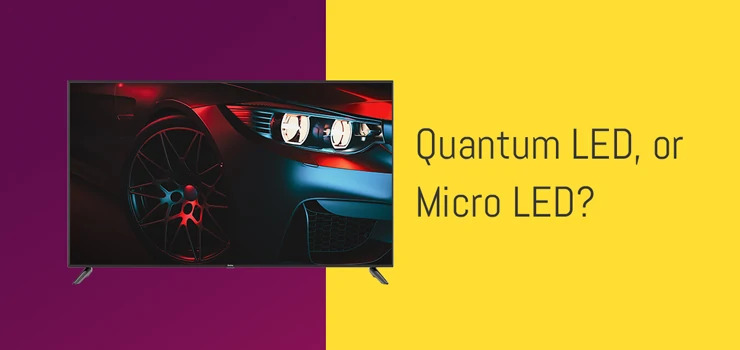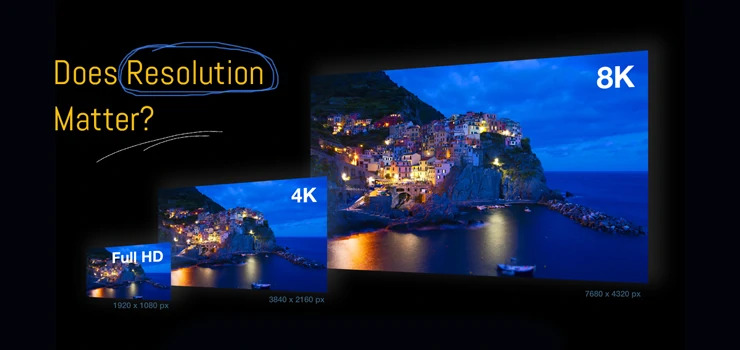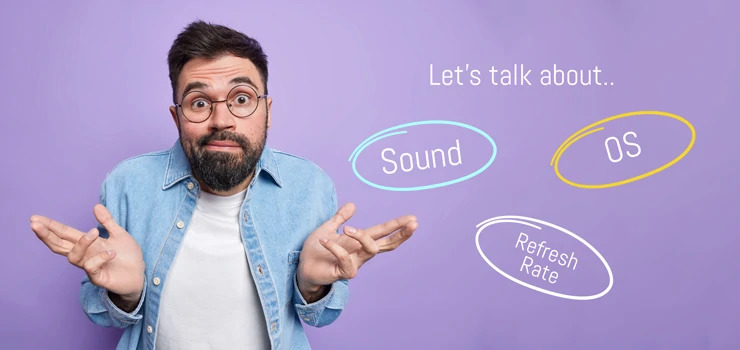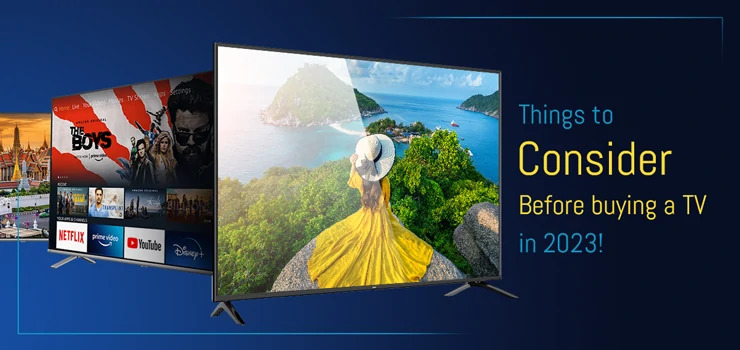TVs are updating at a rapid rate as of 2022. You can not just buy a Smart TV by the looks anymore. Features are so advanced now, that even OLED TV is becoming old! Yes, you heard it right. The wave of Covid-19 pushed the TV industry so much, that giants like Samsung, SONY & LG have redefined what we know as the latest.
So, what features to expect by the year 2023 ahead? Since a TV lasts more than 3 years on average, always consider the latest features. Therefore, your buying decision remains wise & future-proof.
LED TV: Latest Technology
Talking from future proofing, we can not emphasize QLED TVs more if you are buying one after 2022. This year has been one of those when Television technology saw a huge bump. Because Organic Light Emitting Diode, OLED, can physically turn off as the signal commands, blacks are ‘organic’ here. As a result, OLED gives you the truest black. But don’t stop with just that. QLED is what you should get in any post-2022 purchase.

Quantum LED TV
QLED technology, built with LCD-LED tech, lets the LEDs on your screen individually charge up or discharge as the scene demands. Which results in superior brightness or darkness on the TV. It also allows the display to open for a far more accurate color presentation. With a QLED TV, the picture gets clearer contrast and enhanced shadows.
Micro LED TV
A Micro LED is 100 times smaller than a traditional LED. This means you get 100 more LEDs in place of a single LED. That many LEDs give you far more image processing ability. With more LEDs, comes more control over the lost light. All LED panels waste about 75% of the light. But with Micro LED, that problem gets solved. Every Micro LED can charge up separately. This way, this loss is reduced significantly.
With a greater command of foreground contrast and intelligent programming, the color space is superior on a Mini or Micro LED display. LG’s Nano Cell TVs are already adopting the tech. While SONY is working on the same tech, they named it the Mini LED Series.

Consider a Higher Resolution
As of 2022, all the top brands upscaled most of their TVs to 4K resolution. It is because more pixels will always give you more details. Higher resolution also opens up doors to features like HDR and zonal contrast adjustment. Therefore, we recommend you buy a 4K TV. Although Full HD and 2K TVs remain, 4K is more popular for superior picture quality. So, what’s the big deal with that many pixels?
4K Upscaling is a Trend
4K image upscaling is a feature that takes a regular FHD input and dials it up to 4K. It is achieved by tuning the source data with AI-infused algorithms. Now, even consumer-grade cameras, action cams & drones record 4K videos. And with content-sharing platforms like YouTube & Facebook, everyone is a creator. You can see the Japanese Football spectators carrying the latest GoPro to the FIFA 2022 Qatar World Cup.
Streaming services like Netflix, Hulu, Amazon Prime, and AppleTV offer tremendous amounts of resolution in 2022. Our observation from 2022 says there will hardly be any OTT content below 4K by 2025. If you are wise enough it’s time to get a 4K Smart TV and nothing less.
8K for Flagship Owners
If you are one of those who love to game or watch on a big screen, the sweetest deal for you can be an 8K TV like the LG 75NANO95 NanoCell. More resolution is always better for precise gaming. An 8K TV gives you the edge of four times more resolution over 4K. Whether playing from your Gaming PC, XBOX, or PlayStation, an 8K TV is sure to give you better gameplay.
However, judging from the streaming & broadcasting perspective, 8K service is nowhere to be found. Because the necessary bandwidth for 8K reception is as costly as broadcasting. We would not recommend going for this right away. But if you are a fan of the flagships, why not! This will become a standard today or tomorrow, probably with many side dishes on the plate.

Sound: Second Most Important Feature
All the top brands are up to redefining the audio spectrum of TVs. SONY BRAVIA XR series features a sound system where they put a pair of sound actuators under the screen. Vibrating the screen at a nano-level, it makes you think that the sound is coming from the screen. SONY calls it Acoustic Surface technology. Currently, selected BRAVIA XR OLED models have this feature like the Bravia XR 77A80J.
Another feature already available in all the major players of the TV industry is auto-calibration for sound. Using this, the TV automatically detects where you sit and adjusts sound. From scale to pitch, everything gets fine-tuned from more than millions of points in the database. This way, every seat is the best seat and you have the most immersive experience. The Bravia XR 77A80J features this.
Additional Features to Keep in Mind
Apart from just streaming services and 4K resolution, modern TV technology offers far more features. There’s advancement in almost everything you can imagine. From Operating System (OS) to Sound Processing, and Refresh Rate to Object-based Image Projection, many features are coming in 2023. Below is a brief list of features that already exist.
Refresh Rate on TV
Refresh Rate is the number of times your display updates with new information. A typical television features only 30Hz. This means every second the signal on the LED in your TV turns on and off 30 times. The more times your TV Panel “refreshes”, the smoother becomes frame transition. In 2022, most Android TVs offer 60Hz and more upgrades are on the way.
Variable Refresh Rate
Variable Refresh Rate (VRR) is a Smart TV feature that constantly traces each of the frames for adjustment. It counts what time each frame takes to render, and adjusts the refresh rate to that time. This way, while the refresh rate and frame rate are not equal, the possibility of horizontal tearing reduces. In layman’s terms - you have the most smooth transition each and every moment. Graphics technology developers like AMD call it the FreeSync while Nvidia terms it as G-Sync. However, they are pretty alike except for the mathematics behind.
SONY’s Bravia KD-85X85J is one of those TVs that come with a refresh rate of 60Hz and is VRR-capable. With VRR it can drastically change its refresh rate to adjust errors like motion blur. Samsung and LG also produce VRR TVs - like the Samsung 85Q70A 85 Inch QLED 4K and LG 65NANO95.
Connectivity: HDMI 2.1
Now, we enter the upper spectrum of signal conversion. This is where features like the HDMI interface enter. There are multiple vendors for TV graphics and all of them tend to imply their unique features. HDMI signal ports allow your super-sampled audio and upscaled video from the Gaming Console or Set Top Box (like Akash DTH) to be successfully transferred to your new & expensive TV.
No matter which Audio-Video technology your TV uses, lacking proper connectivity, you pretty much lose everything you paid for. Therefore, we seriously recommend that your next QLED TV features an HDMI 2.1. Starting from an unimaginable resolution like 4k-120Hz or 8K-120Hz, Dolby Atmos, DTS, Dolby Vision, ethernet toVRR; HDMI 2.1 covers all.
Operating System
Dialing all those futuristic features is easy if your Operating System is the right one. Out of all, the most advanced and precise TV OS is Google’s Android. Android OS TVs are clean and easy to navigate. Android’s Play Store gives access to millions of apps to boost your multimedia. You can even control a complete ecosystem with a good Operating System on TV.
Software Certifications
Software certifications are important for specific task handling. Certification means compatible devices will generate images according to their casting signal, and specs with optimum results. IMAX, DaVinci Resolve, etc organizations certify specific series or models for specific tasks. Streaming service providers & OTTs like Netflix, AppleTV+, or Amazon also give certification. Consumers should consider these features before buying a TV in 2023.
Dolby Vision
Dolby Vision is an advanced technology from Dolby Laboratories for HDR (High Dynamic Range) devices. Dolby Vision allows a creator to optimize videos frame by frame, with dynamic metadata. Acclaimed cinema directors use this for pin-point color grading and contrast in their movies.
If your TV features Dolby Vision, you have the ultimate weapon to experience proper “Home Theater”. Because, you are watching the colors, brightness, or darkness exactly as the director envisioned. This is a great solution to bypass purchasing studio equipment for those who are not into multi-million dollar visual production.
Dolby Atmos
Dolby Atmos is the audio technology for optimizing sound. Televisions with Dolby Atmos give 3D surround Upscaling, required for super sampling variable bitrates with a 3D sound setup. Spatial Audio, 360-degree immersive sound, and Dolby Atmos certification are some of the audio features that you should consider.
Virtual Assistance
Finally, Virtual Assistant. A virtual assistant is an AI-based, software-driven bot that helps you execute commands with your voice. Google Assistant is the most famous worldwide, while Amazon’s Alexa is also popular. With these features, your control over the smart appliances becomes as sweet as the picture you are about to enjoy.
Buy From A Renowned TV Store
We hope you are “super-charged” with the latest features in the TV market. With these “Quantum” insights, maybe you are looking forward to immersing in a futuristic version of the Home Theatre experience. So, if you are buying soon, one question remains - from where?
Last but not least, we Can Not Emphasize more on this. Get the TV (or any Gadget, to speak) from a showroom of the brand. If not, at least from an authorized, renowned dealer. Why? It’s because electronic gadgets are fragile. Only professional, renowned stores can deliver the product with the official warranty in fresh condition.
In Bangladesh, you can get a Smart TV with all the features & models we talked about from Star Tech. Also, furnish your cutting-edge Smart TV with authentic accessories from our TV Shop. Don’t miss out on special offers as we often run exciting campaigns.










Comments
There are no comments for this Article.